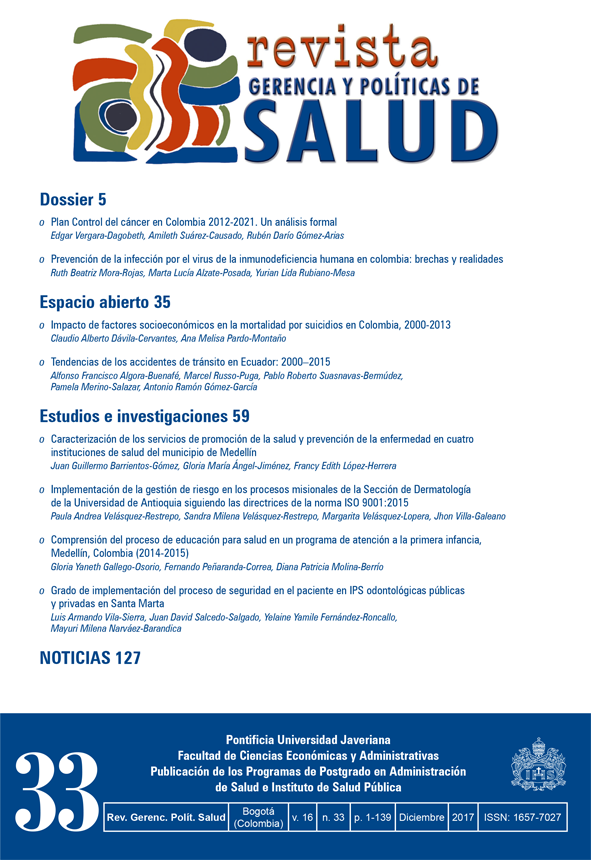Abstract
Risk management in health care services is a process that takes into account the planning and implementation of strategies aimed at controlling possible adverse effects that arise during the attention to users, quality of service, and patient safety. This article reports on the development of the risk management system for the mission processes of the Dermatology Section of the Universidad de Antioquia, as well as on the main results obtained to date and the way in which the Quality Management System (under the ISO 9001 standard) worked as a complement and support to the implemented risk management system. Five inherent risks were identified for the Dermatopathology Laboratory, six for Other Dermatological Procedures, and eight for the Photodermatology Unit, all of which were analyzed and evaluated; the relevant controls were implemented afterwards.
2. Gutiérrez CL, Morales LEI, Castellanos JM V. H-OTPOT Herramienta de convergencia en el sistema de gestión de la calidad basado en la norma ISO 9001:2015. En: Global Conference on Business and Finance Proceedings. 2015. p. 921-9.
3. Colorado Canola A, Escobar Mora N, Botero Morales J. Vigilancia tecnológica para la gestión del riesgo tecnológico en el sector salud asociado a la norma ISO 31000. Rev Ing Biomédica. 2015;9(18):117-25.
4. Pardo R, Jara A, Menchen B, Padilla D, Martín J, Hernández J, et al. Puesta en marcha de una unidad de gestión de riesgos clínicos hospitalaria. Rev Calid Asist. 2005 Jun;20(4):211-5.
5. Ríos Rodas LJ. Bases conceptuales para la elaboración de un modelo de seguridad del paciente [trabajo de Especialización en Auditoría en Salud]. Medellín: Universidad de Antioquia; 2010.
6. Ministerio de la Protección Social-República de Colombia. Decreto número 1011 del 2006. 7. Congreso de Colombia-República de Colombia. Ley 1122 del 2007.
8. Ministerio de la Protección Social-República de Colombia. Resolución 2003 del 2014.
9. Ministerio de Salud y Protección Social-República de Colombia. Guía técnica de buenas prácticas en seguridad del paciente. 2010.
10. Instituto Colombiano de Normas Técnicas y Certificación (Icontec). Norma técnica Colombiana NTCISO
9001-2015: Sistema de Gestión de la Calidad.
11. Instituto Colombiano de Normas Técnicas y Certificación (Icontec). Norma técnica Colombiana NTC-ISO 31000-2011: Gestión del riesgo, principios y directrices.
12. McKernan J. Investigación-acción y currículum : métodos y recursos para profesionales reflexivos. Madrid: Morata; 2001.
13. Mejía RC. Identificación de riesgos. Medellín: Fondo Editorial Universidad Eafit; 2013. 14. Project Management Institute. A guide to the project management body of knowledge (PMBOK ® Guide). 2000th ed. Newtown Square, Pennsylvania USA: Library of Congress Cataloging-in-Publication Data; 2000.
15. Carreño ML, Cardona OD, Barbat AH. Sistema de indicadores para la evaluación de riesgos. Barcelona: Centro Internacional de Métodos Numéricos en Ingeniería; 2005.
Copyright notice
The Journal Management and Health Policies is registered under the Creative Commons Recognition 4.0 International license. Therefore, this work can be reproduced, distributed and publicly communicated in digital format, provided that the name of the authors and the Pontificia Universidad Javeriana are recognized. It is allowed to quote, adapt, transform, autoarchive, republish and create from the material, for any purpose (including commercial), provided that authorship is properly acknowledged, a link to the original work is provided and if changes have been mad. The Pontificia Universidad Javeriana does not retain the rights over published works and the contents are the exclusive responsibility of the authors, who preserve their moral, intellectual, privacy and publicity rights.
The endorsement of the intervention of the work (revision, style correction, translation, layout) and its subsequent disclosure is granted through a license to use and not through a transfer of rights, which means that the journal and the Pontificia Universidad Javeriana disclaims any liability that may arise from ethical misconduct on the part of the authors. As a result of the protection provided by the license for use, the journal is not obliged to publish retractions or modify the information already published, unless the erratum arises from the process of editorial management. The publication of contents in this magazine does not represent royalties for taxpayers.


